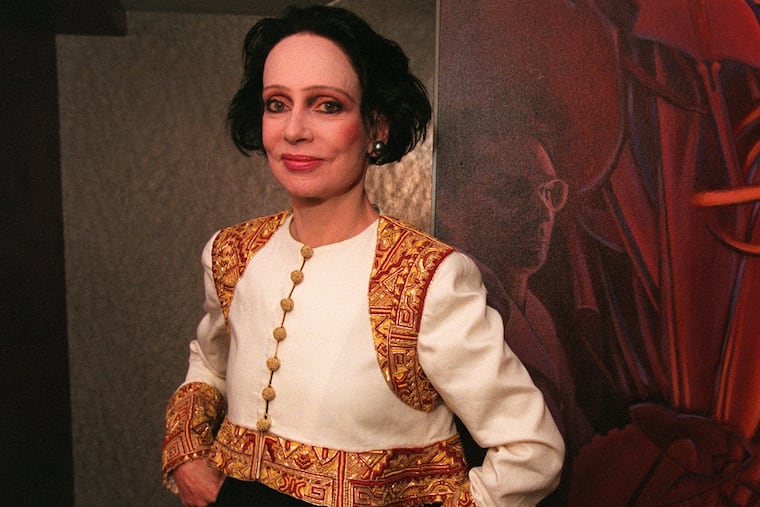Mary McFadden, celebrated fashion designer, art scholar, author, and world traveler, has died at 85
She created silky dresses with crystal pleats and gold embroidery, quilted jackets with beaded collars, and bejeweled semi-breastplates. “My clothes are free and fluid,” she said in 1979.

Mary McFadden, 85, of New York, celebrated fashion designer, art scholar, editor, author, and world traveler, died Friday, Sept. 13, of myelodysplasia at a private residence in Southampton, N.Y.
Inspired by ancient Islamic art and jewelry, Greek and Egyptian sculptures, 18th-century Russian apparel, surrealist painters, and other cultural touchstones she encountered on her many journeys around the world, Ms. McFadden designed women’s clothing for three decades that other fashionistas described as “stylish and dramatic” and “pure timeless silhouettes.” Colleagues called her a “design archaeologist” due to her eclectic connections to historical dress and accoutrements, and Jacqueline Onassis, Babe Paley, and other notable women popularized her creations in the 1970s, ’80s, and ’90s.
“You can almost always spot at least one of the timeless designs at society balls and weddings,” Inquirer writer Roy H. Campbell said in a 1997 article.
Ms. McFadden favored silky dresses with crystal pleats and gold embroidery, quilted jackets with beaded collars, and bejeweled semi-breastplates. “My clothes are free and fluid,” she told The Inquirer in 1979.
Models wore her designs on runways in Philadelphia, New York, London, Tokyo, and elsewhere around the world, and The Inquirer’s Campbell described her signature pieces as “exquisite silks cascading with tight pleats in a breathless array of colors and designs, usually cut close to the body but rarely tight.”
She used textiles from Australia, China, Africa, India, and elsewhere, and specialized in a pleating technique she developed and called Marii, a Japanese version of her first name. She later added jewelry, upholstery fabrics, bed linens, eyeglass frames, wall coverings, and perfume to her creative portfolio, and became a star on the QVC home-shopping network.
She called her collections “Fire,” “Greece, the Classical Period,” “Sultan Saladin,” and “The Tales of Genji,” and she said in a 2010 interview with Maryland Public Television: “Each collection was based on an ancient civilization.”
Examples of her work have been exhibited at Drexel University and Moore College of Art and Design in Philadelphia, the Metropolitan Museum of Art in New York, National Museum of Women in the Arts in Washington, Allentown Art Museum, Massachusetts College of Art and Design in Boston, and elsewhere in the United States and around the world. Drexel is currently hosting her exhibition “Modern Ritual: The Art of Mary McFadden.”
Her big break came in 1970 when Vogue magazine published three of her silk designs and New York stores added them to their inventories. She founded Mary McFadden Inc. in 1976 and closed her Seventh Avenue showroom in 2002.
She also collected art, and her showroom featured wood and ceramic sculptures, a carved screen from Thailand, and other treasures she discovered on her many world tours. She won awards from Neiman Marcus and Moore College of Art and Design, and was inducted into the Coty Fashion Hall of Fame in 1979.
She served as the first female president of the Council of Fashion Designers of America in 1982 and ’83, and colleagues there called her “a renaissance woman” and “true American fashion original” in an online tribute. Her brother John said: “She had great gifts and mighty talents.”
She was an editor for Vogue in South Africa in the 1960s and later a writer and editor for the magazine in New York. She appeared often in The Inquirer and other publications, and cowrote Mary McFadden: A Lifetime of Design, Collecting, and Adventure in 2012.
Her own appearance became part of her public persona, and Inquirer writer Maralyn Lois Polak described Ms. McFadden in a 1979 article as “a mannequin not quite come to life. … her remarkably blank face with its alabaster pallor … her black hair parted in the center and blunt-cut to her ear tips.” Ms. McFadden told Polak: “Beauty fades, but individualism lasts.”
Mary Josephine McFadden was born Oct. 1, 1938, in Manhattan. Her father grew up in Villanova, and she spent much of her time in the Philadelphia area as an adult. She lived in Memphis and New York as a girl, was an avid painter in elementary school, and started making her own clothes at 13 because “I was physically small, and I didn’t like what was available to wear,” she told The Inquirer in 1979.
She graduated from Foxcroft School in Virginia and studied sociology and anthropology at Columbia University. She also attended the Sorbonne in Paris and the Traphagen School of Fashion in New York.
She worked as a public relations director for fashion designer Christian Dior in New York after college. She married Philip Harari in 1964, moved to South Africa, and they had daughter Justine.
After a divorce, she married and divorced Frank McEwen, Armin Schmidt, Kohle Yohannan, and Vasilios Calitsis. She said she also had several “spiritual” marriages over the years. Her daughter died in 2023.
Ms. McFadden played golf and tennis when she was young. Her mother died of ovarian cancer in 1992, and she coordinated with several organizations afterward to raise millions of dollars for cancer research and awareness projects.
Fashion, she said in her 2010 TV interview, “is something extraordinary,” and “something extraordinary takes us out of the commonality of our life.”
In addition to her brother, Ms. McFadden is survived by two half-brothers and other relatives. Another brother died earlier.
A celebration of her life is to be held later.